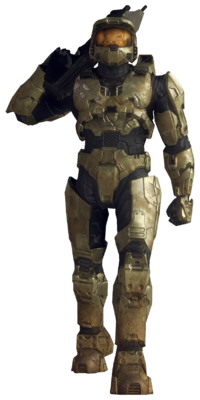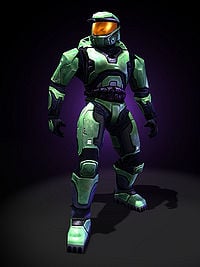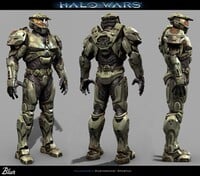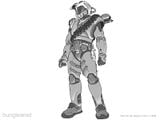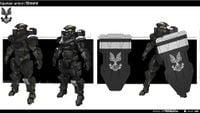MJOLNIR Powered Assault Armor: Difference between revisions
From Halopedia, the Halo wiki
Sith Venator (talk | contribs) |
CMDR RileySV (talk | contribs) No edit summary |
||
| (55 intermediate revisions by 21 users not shown) | |||
| Line 1: | Line 1: | ||
{{ | {{Status|Canon}} | ||
[[File:Halo3MC.png|200px|thumb|John-117 in his Mark VI Mjolnir armor]] | [[File:Halo3MC.png|200px|thumb|John-117 in his Mark VI Mjolnir armor]] | ||
{{Quote|Project MJOLNIR will make the Spartans into something . . . new. Something I could never forge them into. I can’t fully explain — that damned ONI spook is still here listening — just trust [[Dr. Halsey]].|CPO [[Mendez]] to [[John-117]] about final phase of Spartan training}} | {{Quote|Project MJOLNIR will make the Spartans into something . . . new. Something I could never forge them into. I can’t fully explain — that damned ONI spook is still here listening — just trust [[Dr. Halsey]].|CPO [[Mendez]] to [[John-117]] about final phase of Spartan training}} | ||
The '''MJOLNIR Powered Assault Armor System'''<ref>[http://www.halowaypoint.com/en-us/intel/armor ''Halo Waypoint -Halo 4 Armor'']</ref> (pronunciation:''ˈmjɔːlnɪər'', ''myol-neer'') is a technologically advanced [[Powered exoskeleton|combat exoskeleton system]] designed to vastly improve the strength, speed, agility, reflexes and durability of a [[SPARTAN Program|Spartan]] supersoldier. Though the development program is rendered in all capital letters (''i.e.'' Project MJOLNIR), the armor itself is called '''Mjolnir'''.<ref>''Halo 4: The Essential Visual Guide'', page 229</ref> The suit is named | The '''MJOLNIR Powered Assault Armor System'''<ref>[http://www.halowaypoint.com/en-us/intel/armor ''Halo Waypoint -Halo 4 Armor'']</ref> (pronunciation:''ˈmjɔːlnɪər'', ''myol-neer'') is a technologically advanced [[Powered exoskeleton|combat exoskeleton system]] designed to vastly improve the strength, speed, agility, reflexes, and durability of a [[SPARTAN Program|Spartan]] supersoldier. Though the development program is rendered in all capital letters (''i.e.'' Project: MJOLNIR), the armor itself is called '''Mjolnir'''.<ref>''Halo 4: The Essential Visual Guide'', page 229</ref> The suit is named after the [[Wikipedia:Mjölnir|hammer of Thor]] in Norse mythology. | ||
==Overview== | ==Overview== | ||
[[File:Still 01.jpg|thumb|The Mark V MJOLNIR armor.]] | [[File:Still 01.jpg|thumb|The Mark V MJOLNIR armor.]] | ||
Created parallel to the [[SPARTAN-II program]] by the [[Office of Naval Intelligence]]'s [[Materials Group]], the Mjolnir armor is the most advanced piece of tactical military hardware in human hands. Each suit alone costs as much as a small starship. | Created parallel to the [[SPARTAN-II program]] by the [[Office of Naval Intelligence]]'s [[Materials Group]], the Mjolnir armor is the most advanced piece of tactical military hardware in human hands. Each suit alone costs as much as a small starship. The brainchild of [[Catherine Halsey|Dr. Catherine Halsey]], MJOLNIR is an attempt to create a powered exoskeleton capable of taking full advantage of the physical capabilities of a Spartan.<ref name="sybex">'''Halo: Combat Evolved PC Strategy Guide''', ''page 5''</ref> MJOLNIR is considered by the [[Librarian]] to be the fulfillment of a millennia-old [[geas]] she had implanted in humanity a hundred millenia earlier, intended to help them [[Reclaimer|reclaim]] the [[Mantle]].<ref>'''Halo 4''', campaign level ''[[Reclaimer (level)|Reclaimer]]''</ref> | ||
Spanning over three decades of development, Project MJOLNIR encompassed more than just a suit of armor, but as a pioneering effort intended to shatter current technological barriers. In its final iteration, Mjolnir is a highly advanced suit capable of further enhancing the Spartans' physical performance while also doubling as a platform capable of handling an artificial intelligence network.<ref name="ENCY">'''[[Halo Encyclopedia (2009 edition)]]''', ''page 88''</ref> | Spanning over three decades of development, Project MJOLNIR encompassed more than just a suit of armor, but as a pioneering effort intended to shatter current technological barriers. In its final iteration, Mjolnir is a highly advanced suit capable of further enhancing the Spartans' physical performance while also doubling as a platform capable of handling an artificial intelligence network.<ref name="ENCY">'''[[Halo Encyclopedia (2009 edition)]]''', ''page 88''</ref> | ||
| Line 23: | Line 23: | ||
==Armor generations== | ==Armor generations== | ||
Before Dr. Halsey | Before Dr. Halsey initiated Project MJOLNIR, the [[UNSC Navy]] had developed various designs and prototypes for powered exoskeletons and armour systems, including the [[Mark I prototype exoskeleton|Mark I exoskeleton]],<ref name="FoR3">'''Halo: The Fall of Reach''', ''page 71'', (2001 edition) ''page 81'', (definitive edition) ''page 90'' (2010 edition)</ref> the [[Mark III exoskeleton]],{{Ref/Book|Id=EVGCyclops|EVG|Pg=44}} [[ORION armor]],{{Ref/Site|Id=CF|URL=https://www.halowaypoint.com/en-us/news/anniversary-armory|Site=Halo Waypoint|Page=Canon Fodder - Anniversary Armory|D=03|M=11|Y=2021}} and [[HRUNTING Mark I exoskeleton|HRUNTING Mark I]].{{Ref/Reuse|journal1}} In [[2510]], Halsey inspected much of this previous work while performing a program review of [[Project HRUNTING]] on behalf of ONI. She judged HRUNTING to be an "interesting failure" for its lack of innovation, and inability to exploit recent technological breakthroughs.{{Ref/Book|Id=Enc22p77|Enc22|Page=77}} Later, during the early stages of planning for Project: MJOLNIR, Halsey would ultimately choose to start from scratch, due to both the limitations inherent in the previous antiquated designs,{{Ref/Reuse|journal1}}{{Ref/Reuse|FoR3}} and an unwillingless to shoulder the administrative burden of taking over and reforming an existing project such as HRUNTING. Instead, Halsey preferred to start fresh with an entirely new team, who were unbound by pre-existing dogma and assumptions about powered exoskeleton design.{{Ref/Reuse|Enc22p77}} | ||
The initial genesis of what would become Project: MJOLNIR can be traced back to as early as [[2511]]. By that year, Halsey was in communication with [[UNSC rank structure|Vice Admiral]] [[Michael Stanforth|Hieronymus Stanforth]] regarding the production of an armour system to complement the SPARTAN-II program, and had begun to brainstorm names for the project. In July, she penned an entry in her [[Dr. Halsey's personal journal|personal journal]] speculating that the [[Wikipedia:Piezoelectricity|reverse piezoelectric effect]] could be used to produce a bodysuit that enhanced the wearer's strength, by causing the suit to intelligently deform in response to the wearer's nerve impulses, adding extra force to their movements. This would become one of the defining features of MJOLNIR armour.{{Ref/Reuse|journal1}} | |||
Work on Project: MJOLNIR would not begin in earnest for a further four years, however, with development beginning in [[2515]].{{Ref/Reuse|ENCY}} In that year, the project opened with a experimental phase, with a development platform that would be retroactively termed "Mark I" being used as a testbed for numerous trials and experiments over the following years.{{Ref/Reuse|Enc22p77}} The armour underwent significant iteration in the decade following, with at two further distinct prototype platforms emerging and forty prototype suits being produced across these three platforms, before the first production model - what would come to be known as Mark IV - was finalised. Mark IV was put into production in mid-[[2525]] and issued to the surviving SPARTAN-II candidates in November of that year.{{Ref/Reuse|FoR2}}{{Ref/Reuse|ENCY}} | |||
Initially, MJOLNIR was envisaged as an evolving platform, constantly and continuously updated with the latest technology as it became available. After a full decade, however, the Office of Naval Intelligence decided that it was no longer possible to facilitate this approach, much to Halsey's chagrin. In [[2535]], they mandated that MJOLNIR adopt a generational categorisation system, for the purposes of serialisation, prioritisation and progress-tracking, and as a means of fiscal oversight. Despite her reservations, Halsey agreed to the introduction of such a system, and produced a roadmap for future generations of the armour, in the hopes that it would "keep the accountants out of [her] hair and [her] work". The system devoted Marks I, II and III to prototype platforms produced between 2515 and 2525, while categorising all production models of MJOLNIR up until that point as Mark IV. Three further planned iterations, Marks V, VI and VII, were included in the roadmap, complete with rough technical specifications.<ref name="journal2">'''Dr. Halsey's personal journal''' ''January 7, 2535''</ref> Nevertheless, Halsey rarely used the "Mark" verbiage to describe the suits, due to her objections with its imposition by ONI.{{Ref/Reuse|Enc22p77}} | |||
After the end of the Human-Covenant War, the Materials Group developed the second system-wide generation of MJOLNIR, simply designated GEN2, as a response to the SPARTAN-IV project. GEN2 is lighter than the Marks IV through VI and is far more modular than previous systems. The previous iterations of MJOLNIR were retroactively designated GEN1 to distinguish them from the GEN2.<ref name="O+A">[http://halo.xbox.com/halo4#!an-epic-universe/ordnance-armor/cbbca9b3-5108-41aa-aa21-9b523de68266 '''Halo 4''': ''ORDNANCE + ARMOR'']</ref><ref name="Gameplay">[http://halo.xbox.com/halo4#!halo-evolved/gameplay/31afe32b-0e07-45c0-9424-3adc6e1eadca '''Halo 4 Official Site:''' ''GAMEPLAY'']</ref> | |||
=== | ===Pre-production prototypes=== | ||
<!-- They should call this GEN0 in canon --> | |||
Before any generation of MJOLNIR made it into formal production, a full decade was spent in the research and development phase of the program. Three major distinct development platforms emerged over this period, which would be retroactively designated Mark I, II and III, with each successively refining and building upon the last. Across these three platforms,{{Ref/Note|Id=EncFortySuits|The 2009 and 2011 editions of the ''Halo Encyclopedia'' claim that these manufactured suits were of the Mark I generation specifically, and that they were later "scrapped" - suggesting an intention to actually put them into service. However, the 2022 edition of the Encyclopedia revises this claim, stating that the "at least forty" manufactured suits were of the Mark I, II and III platforms overall (not Mark I specifically), and establishes that they were only ever testbeds for experimentation, never production-ready suits of armour. Due to the recency of the 2022 edition, and the frequent inaccuracies in the 2009 and 2011 encyclopaediae, this article favours the 2022 edition.}} at least forty different physical suits were assembled, each to a varying stage of completeness with regards to systems integration and functionality. Suits from this prototypical generation of MJOLNIR were never intended to be put into service, instead serving merely as development platforms for Halsey and her team to iterate on.{{Ref/Reuse|Enc22p77}} Ultimately, the key failing of all three of these prototype platforms was the reliance on a local, external power source, requiring either a physical tether or for the user to remain within range of [[broadcast power]]. This made the designs impractical on the battlefield, as their range was severely limited by the lack of a mobile power source.{{Ref/Reuse|ENCY}} | |||
====Mark I==== | |||
First developed in [[2515]], the Mark I was a development platform which served as a testbed for Halsey and her team to experiment with during the early stages of MJOLNIR development. Though bulky, unwieldy and difficult to control, the Mark I nevetherless pioneered the artificial muscles, embedded computer systems and control software that would become core to the MJOLNIR armour in later generations.{{Ref/Reuse|Enc22p77}} The suit also contained a cutting-edge onboard computer that could assist the wearer by transmitting tactical and communications information to the standard neural implant issued to a soldier, though the suit did not possess the ability to carry an AI.{{Ref/Reuse|ENCY}} Despite these successes, the Mark I had one fatal flaw which would have to be overcome before MJOLNIR could ever be truly practical in the field: due to the tremendous amount of energy needed to power it, it had to remain physically tethered to a power source while in use.{{Ref/Reuse|ENCY}}{{Ref/Reuse|Enc22p77}}{{Ref/Note|The 2009 and 2011 editions of the ''Halo Encyclopedia'' also claim that the Mark I allowed the user to lift up to two tons (4,000 pounds) and run at 32 km/h (19.88 mph) for extended periods of time. However, these statistics were ascribed to the unrelated [[Mark I prototype exoskeleton]] by ''[[Halo: The Fall of Reach]]'', and misattributed to MJOLNIR Mark I by the ''Encyclopedia''. Thus, they are not listed on this article.}} | |||
=== | Research and development for the Mark I was carried out at Section Three's headquarters inside [[CASTLE Base]] on [[Reach]], though the final assembly of components occurred at the [[Damascus Materials Testing Facility]] on [[Chi Ceti IV]]. The Mark I remained in development for a considerable amount of time before being succeeded by Mark II and later generations.{{Ref/Reuse|ENCY}}{{Ref/Note|The 2009 and 2011 editions of the ''Halo Encyclopedia'' state that it took a decade to develop the MJOLNIR Mark I. However, given that development of MJOLNIR only began in 2515, and that Mark IV was submitted to evaluation for mass production in February 2525, this would leave only 2 months for Mark II, III and IV to be produced. Given the implausibility of this, and the fact that the 2009 and 2011 ''Halo Encyclopediae'' are known to be frequently inaccurate, this article chooses to ignore this stated timeframe.}} Numerous Mark I suits were produced in various stages of completion, but as prototypes, they did not see use in battle.{{Ref/Reuse|ENCY}}{{Ref/Reuse|Enc22p77}}{{Ref/NoteReuse|EncFortySuits}} | ||
====First generation | |||
====Mark II==== | |||
A successor to Mark I, the Mark II platform was a refinement on the same basic system as the Mark I, which increased the suit's mobility and range.{{Ref/Reuse|Enc22p77}} This greatly improved mobility was enabled by the suit's slimmer profile. The Mark II also included a refractive coating to help disperse heat from explosions or directed energy weapons, and improved self-sealing systems in the event of damage while the unit was in a vacuum or an inhospitable atmosphere. However, the suit still needed to be physically tethered to a fusion generator, so despite being the most powerful piece of military hardware of its time, it was still impractical for battlefield deployment.{{Ref/Reuse|ENCY}} | |||
====Mark III==== | |||
Similar to the Mark II, the Mark III system was a further refinement on the same systems pioneered with the Mark I, and also featured increased mobility and range versus its predecessors.{{Ref/Reuse|Enc22p77}} Its major innovation, though, was that it was the first iteration to incorporate a wireless power receiver so that power could be transmitted directly to it, via [[broadcast power]]. This eliminated the need for a physical connection to the power source.{{Ref/Reuse|ENCY}} | |||
Though an improvement, this design was still quickly rejected, for two main reasons. First, the armor still had a limited operational range as it had to remain within range of a bulky, immobile [[generator]]. Second, if said generator was disabled or destroyed, the suit would become inoperable, leaving its user locked inside the now-inoperable shell, helpless against enemy attacks.{{Ref/Reuse|ENCY}} | |||
===GEN1 - First generation=== | |||
[[File:MarkIV model.jpg|thumb|The first iteration of the Mark IV Mjolnir platform]] | [[File:MarkIV model.jpg|thumb|The first iteration of the Mark IV Mjolnir platform]] | ||
=====Mark IV | After a decade of research and development, MJOLNIR would, in [[2525]], enter what retroactively became known as GEN1 - the first generation of MJOLNIR to be actively deployed in the field. This generation lasted throughout the [[Human-Covenant War]], and was described as "revolutionary, in both form and function". Over the course of the generation, the design would see significant iteration and refinement, with the addition of many notable upgrades, including personal [[energy shielding]] and the ability to host an on-board AI to assist the wearer.{{Ref/Book|Id=Enc22p78|Enc22|Page=78-79}} Nevertheless, GEN1 was not without its drawbacks: it required extremely complex manufacturing methods to create, and each suit had to be custom-tailored for its Spartan wearer.{{Ref/Book|Id=Enc22p80|Enc22|Page=80}} | ||
====Mark IV==== | |||
{{Main|MJOLNIR Powered Assault Armor/Mark IV}} | {{Main|MJOLNIR Powered Assault Armor/Mark IV}} | ||
Despite the failure of the three earlier iterations of MJOLNIR, the MJOLNIR Mark IV armour would become the first MJOLNIR suit to see mass production and deployment onto the battlefield. Spearheaded by Dr. Catherine Halsey, the Mark IV was a radical redesign of the previous iterations. Most notably, it used an embedded miniature fusion reactor within the armour itself to power the suit, eliminating the cumbersome external generators that had plagued previous iterations. The MJOLNIR Mark IV armor was first fielded in November 27, 2525 and remained in service until November 24, 2551,<ref>[http://halo.bungie.net/News/content.aspx?type=topnews&link=BWU_012910 '''Bungie.net''': ''Bungie Weekly Update: 01.29.10'']</ref> though it received innumerable iterative upgrades in the interim. | |||
====Mark V==== | |||
{{Main|MJOLNIR Powered Assault Armor/Mark V}} | {{Main|MJOLNIR Powered Assault Armor/Mark V}} | ||
The Mjolnir Mark V is the first major upgrade of the system and introduced two revolutionary technologies for battlefield purposes: energy shielding reverse-engineered from Covenant technology, providing the user added protection against plasma weapons, and the ability to link a soldier and an [[artificial intelligence]] together to provide the soldier instant intel in the field, along with other functions. In addition to major changes from the Mark IV, hundreds of other technical improvements are incorporated into the Mark V: for example, the fusion packs used to power the suits are half the size of their predecessors. The Mark V was fielded from [[2551|November 24, 2551]] to [[2552#October|October 20, 2552]]. | The Mjolnir Mark V is the first major upgrade of the system and introduced two revolutionary technologies for battlefield purposes: energy shielding reverse-engineered from Covenant technology, providing the user added protection against plasma weapons, and the ability to link a soldier and an [[artificial intelligence]] together to provide the soldier instant intel in the field, along with other functions. In addition to major changes from the Mark IV, hundreds of other technical improvements are incorporated into the Mark V: for example, the fusion packs used to power the suits are half the size of their predecessors. The Mark V was fielded from [[2551|November 24, 2551]] to [[2552#October|October 20, 2552]]. | ||
====Black==== | |||
{{Main|MJOLNIR Powered Assault Armor/Black}} | {{Main|MJOLNIR Powered Assault Armor/Black}} | ||
Created by a top-secret parallel development lab in [[Seongnam]], [[Korea]], MJOLNIR: Black was a standalone "skunkworks" prototype of the Mark VI issued exclusively for [[Team Black]]. It features a number of advances over contemporary Mjolnir exoskeletons. It was used on [[Raid on Verge|Verge]] during the Covenant invasion of the [[Epsilon Eridani system]] and during [[Operation: BLOWBACK]] some time after. | Created by a top-secret parallel development lab in [[Seongnam]], [[Korea]], MJOLNIR: Black was a standalone "skunkworks" prototype of the Mark VI issued exclusively for [[Team Black]]. It features a number of advances over contemporary Mjolnir exoskeletons. It was used on [[Raid on Verge|Verge]] during the Covenant invasion of the [[Epsilon Eridani system]] and during [[Operation: BLOWBACK]] some time after. | ||
====Mark VI==== | |||
{{Main|MJOLNIR Powered Assault Armor/Mark VI}} | {{Main|MJOLNIR Powered Assault Armor/Mark VI}} | ||
The Mjolnir Mark VI is the third primary version of the system. It introduces several technical improvements while refining advanced technologies introduced in the previous system. The first improvement made to the system is a faster recharge time on the suits' energy shield system so that the Spartan-II super soldier does not have to remain in cover for an extended period of time. The second is improved synchronization between the suit and user, this allows the Spartan to jump higher, run faster, and hit harder than a Spartan could previously. | The Mjolnir Mark VI is the third primary version of the system. It introduces several technical improvements while refining advanced technologies introduced in the previous system. The first improvement made to the system is a faster recharge time on the suits' energy shield system so that the Spartan-II super soldier does not have to remain in cover for an extended period of time. The second is improved synchronization between the suit and user, this allows the Spartan to jump higher, run faster, and hit harder than a Spartan could previously. | ||
====Mark VII==== | |||
{{Main|MJOLNIR Powered Assault Armor/Mark VII}} | {{Main|MJOLNIR Powered Assault Armor/Mark VII}} | ||
The Mark VII is the fourth major iteration of the Mjolnir armor introduced in [[2553|January 2553]]. It is lighter than the previous first-generation suits,<ref>'''Halo: Glasslands''', ''page 291''</ref> with new features including limited energy shield shaping and a nanotechnology repair suite. Ultimately, the Mark VII was never widely issued as it was deemed too complex and expensive for mass-production, particularly in light of the development of the more versatile GEN2 platform which enabled more economical optimization for the different Spartan generations in service, while the first generation was mainly optimized for the Spartan-IIs.<ref name="wp mjolnir">[https://www.halowaypoint.com/en-us/universe/tech/mjolnir '''Halo Waypoint''': ''MJOLNIR'']</ref> | The Mark VII is the fourth major iteration of the Mjolnir armor introduced in [[2553|January 2553]]. It is lighter than the previous first-generation suits,<ref>'''Halo: Glasslands''', ''page 291''</ref> with new features including limited energy shield shaping and a nanotechnology repair suite. Ultimately, the Mark VII was never widely issued as it was deemed too complex and expensive for mass-production, particularly in light of the development of the more versatile GEN2 platform which enabled more economical optimization for the different Spartan generations in service, while the first generation was mainly optimized for the Spartan-IIs.<ref name="wp mjolnir">[https://www.halowaypoint.com/en-us/universe/tech/mjolnir '''Halo Waypoint''': ''MJOLNIR'']</ref> | ||
=== | ===GEN2 - Second generation=== | ||
[[File:H4-MJOLNIR-GEN2.png|thumb|[[MJOLNIR Powered Assault Armor/Warrior|Warrior]], the mainline set of the GEN2 MJOLNIR armor]] | [[File:H4-MJOLNIR-GEN2.png|thumb|[[MJOLNIR Powered Assault Armor/Warrior|Warrior]], the mainline set of the GEN2 MJOLNIR armor]] | ||
{{Main|MJOLNIR Powered Assault Armor (GEN2)}} | {{Main|MJOLNIR Powered Assault Armor (GEN2)}} | ||
| Line 72: | Line 81: | ||
The [[MJOLNIR Powered Assault Armor/Warrior|Warrior variant]] serves as GEN2's mainline armor kit, as well as the most widely utilized,<ref>''Halo 4'', Warrior armor description</ref> though the [[MJOLNIR Powered Assault Armor/Recruit|Recruit variant]] is issued to all newly inducted [[Spartan Operations|Spartan]] personnel.<ref>''Halo 4'', Recruit armor description</ref> | The [[MJOLNIR Powered Assault Armor/Warrior|Warrior variant]] serves as GEN2's mainline armor kit, as well as the most widely utilized,<ref>''Halo 4'', Warrior armor description</ref> though the [[MJOLNIR Powered Assault Armor/Recruit|Recruit variant]] is issued to all newly inducted [[Spartan Operations|Spartan]] personnel.<ref>''Halo 4'', Recruit armor description</ref> | ||
=== | ===GEN3 - Third generation=== | ||
{{Main|MJOLNIR Powered Assault Armor (GEN3)}} | {{Main|MJOLNIR Powered Assault Armor (GEN3)}} | ||
MJOLNIR | MJOLNIR GEN3 is the third generation of Mjolnir armor, incorporating lessons learned from GEN2 line of Mjolnir, while also seeking to restore some of the favorable design characteristics and materials of the GEN1 line.{{Ref/Book|Id=Enc22p85|Enc22|Page=85}} GEN1 Mark VII was used as the testbed for GEN3 improvements and when GEN3 Mjolnir began to be produced in [[2559#February|February 2559]],{{Ref/Reuse|HOSFM}}{{Ref/Generic|Id=DH|[[Discover Hope]]}} Mark VII would for the first time receive a full production run.{{Ref/Site|Id=CFDespite|D=30|M=3|Y=2023|URL=https://www.halowaypoint.com/en-us/news/despite-distance|Site=Halo Waypoint|Page=Canon Fodder - Despite Distance}} GEN3 introduced numerous upgrades when compared to the GEN2 platform, including enhanced energy shielding capabilities, a more compact and efficient fusion reactor, and variable-density hydrostatic gel dispersal membranes. While GEN3 did increase the overall use of exotic composites, several innovations in the manufacturing process and a refinement of the platform's modularity have resulted in a suit of armor that is more cost-effective and versatile than both previous generations.{{Ref/Reuse|Enc22p85}} By [[2559#October|October 2559]], GEN3 Mjolnir armor would become the standard armor generation fielded by Spartans,{{Ref/Novel|Id=SOR2|SoR|Chapter 16}} though other armor systems such as the GEN1 [[B-class Mjolnir|Mark V[B]]] platform and its variants have been upgraded to be roughly equivalent to GEN3 Mjolnir, offering Spartans greater choice in the Mjolnir they field.{{Ref/Site|Id=CFParallel|URL=https://www.halowaypoint.com/en-us/news/parallel-threads|Site=Halo Waypoint|Page=Canon Fodder - Parallel Threads|D=30|M=3|Y=2023}} | ||
==Armor components== | ==Armor components== | ||
| Line 85: | Line 94: | ||
*'''[[Polymerized lithium niobocene|Liquid metal crystal piezoelectric layer]]:''' | *'''[[Polymerized lithium niobocene|Liquid metal crystal piezoelectric layer]]:''' | ||
The inner structure of the suit{{Ref/Book|Id=encyc91|[[Halo Encyclopedia (2011 edition)]]|Section=Project: MJOLNIR|Page=91}} is a layer of piezoelectric liquid crystal that deforms along a preferred axis when exposed to an electric charge.{{Ref/Reuse|journaljul}} This layer acts as a sheath or a suit of artificial muscle; this reactive piezoelectric effect increases the mobility, speed, and all-around physical performance of the suit's user,{{Ref/Reuse|journaljul}} doubling their strength and increasing the reaction time of the user by a multiple of five. The material is amorphous, which circumvents a major obstacle in its design: custom fitting millions of the polygonal pieces under the second armor layer.{{Ref/Reuse|journalsep}} Knitted together at a molecular level the liquid crystal material is merely "poured" into a multilayered Sierpinski capillary system where microelectric fields can direct crystallization geometries.{{Ref/Reuse|journalsep}} The only downfall is the material's production, which involves classified super-toxic precursor materials and requires a zero-gravity environment.{{Ref/Reuse|journalsep}} | |||
This makes hand-to-hand combat easier, but also makes the armor difficult to adjust to; a slight motion can be translated into a potentially harmful one if not conducted correctly. For this reason, it is only possible for Spartans to use the armor, as their strengthened muscles and bones are able to withstand the increased power and speed of movement. In unaugmented human bodies, a simple flex results in the system returning a reactive backlash that breaks bones and tears muscles, causing the cascade of agony-induced muscle spasms to be further inflicted back onto the wearer, killing them in seconds. | This makes hand-to-hand combat easier, but also makes the armor difficult to adjust to; a slight motion can be translated into a potentially harmful one if not conducted correctly. For this reason, it is only possible for Spartans to use the armor, as their strengthened muscles and bones are able to withstand the increased power and speed of movement. In unaugmented human bodies, a simple flex results in the system returning a reactive backlash that breaks bones and tears muscles, causing the cascade of agony-induced muscle spasms to be further inflicted back onto the wearer, killing them in seconds. | ||
*'''Knitted-crystal computer memory layer''' | |||
Fitted in between the outer plates and the inner padding, is a crystal computer memory layer. It is knitted at the molecular level and supports the integration of [[Artificial intelligence]]. This type of memory is most often seen on [[Human starship|ships]] and represents 80% of the cost of the suit.{{Ref/Reuse|encyc91}} This layer was present in at least one [[MJOLNIR Powered Assault Armor/Mark V|Mark V]] suit,{{Ref/Novel|FS|Chapter=7}} and likely in at least one Mark VI suit.{{Ref/Note|The image used to illustrate this information in the Encyclopedia is that of the Mark VI. Whether this layer was widely used across all versions of either generation is unknown as Master Chief thus far is the only known Spartan-AI instance.}} | |||
*'''[[Pressure seal]]:''' | *'''[[Pressure seal]]:''' | ||
| Line 93: | Line 105: | ||
*'''Titanium nanocomposite bodysuit:''' | *'''Titanium nanocomposite bodysuit:''' | ||
[[File:H4-MJOLNIR-Skinsuit.jpg|thumb | [[File:H4-MJOLNIR-Skinsuit.jpg|thumb|300px|The [[MJOLNIR Powered Assault Armor/Mark VI|MJOLNIR Mark VI]]'s nanocomposite bodysuit.]] | ||
Sandwiched between the external armor and the internal padding is a thick black armored bodysuit. This suit has numerous functions, small but vital to the safety and survival of the wearer. The bodysuit is made of a titanium-based material, making it very strong and yet very flexible. It also serves as another layer of protection against ballistics attacks and is coated with a heat resistant material to disperse heat from plasma weapons.<ref name="ENCY3">'''Halo Encyclopedia: The Definitive Guide to the Halo Universe''', ''page 90''</ref> | Sandwiched between the external armor and the internal padding is a thick black armored bodysuit. This suit has numerous functions, small but vital to the safety and survival of the wearer. The bodysuit is made of a titanium-based material, making it very strong and yet very flexible. It also serves as another layer of protection against ballistics attacks and is coated with a heat resistant material to disperse heat from plasma weapons.<ref name="ENCY3">'''Halo Encyclopedia: The Definitive Guide to the Halo Universe''', ''page 90''</ref> | ||
| Line 106: | Line 118: | ||
===Outer components=== | ===Outer components=== | ||
*'''Integrated communications helmet:''' | *'''Integrated communications helmet:''' | ||
The Mjolnir helmet is one of the most vital aspects to the MJOLNIR armor system. It is made of [[titanium]] and features a [[heads-up display]], that links to the brain and hands, and can identify equipment and display information about it when it is picked up by the wearer. An environmental control unit that includes filters to remove toxins from the atmosphere, and a rebreather to automatically supply oxygen to the wearer during EVA. In addition the helmet is packed with thermal and motion sensors, communications, solar-powered lighting, and imaging and video gear. | The Mjolnir helmet is one of the most vital aspects to the MJOLNIR armor system. It is made of [[titanium]] and features a [[heads-up display]], that links to the brain and hands, and can identify equipment and display information about it when it is picked up by the wearer. An environmental control unit that includes filters to remove toxins from the atmosphere, and a rebreather to automatically supply oxygen to the wearer during EVA. In addition the helmet is packed with thermal and motion sensors, communications, solar-powered lighting, and imaging and video gear. | ||
| Line 114: | Line 124: | ||
*'''Titanium alloy outer shell''': | *'''Titanium alloy outer shell''': | ||
The outer shell of the Mjolnir armor is composed of a fairly thick titanium alloy. This plating covers the chest, arms, hip, legs, calves, feet and hands. This alloy is very resilient, can take significant punishment, and is nearly impervious to small arms fire. While enough shots from armor piercing rounds will breach the outer shell, the suit can take a few glancing blows from them without compromising the armor. The outer shell of | The outer shell of the Mjolnir armor is composed of a fairly thick titanium alloy. This plating covers the chest, arms, hip, legs, calves, feet and hands. This alloy is very resilient, can take significant punishment, and is nearly impervious to small arms fire. While enough shots from armor piercing rounds will breach the outer shell, the suit can take a few glancing blows from them without compromising the armor. The outer shell of all MJOLNIR suits is covered with a refractive coating to help disperse the heat experienced from Covenant energy weapons. However one or two direct hits from any plasma weapon will compromise the armor plating.{{Ref/Reuse|ENCY3}} | ||
*'''Memory processor superconductor layer''': | *'''Memory processor superconductor layer''': | ||
| Line 134: | Line 144: | ||
This system functions as a self-destruct mechanism in order to prevent a dead Spartan's armor from being compromised by hostiles. It is activated by a series of digits that only the Spartans know. When engaged, it produces a reactor overload that burns everything within a ten-meter radius, then produces a large blast.<ref>'''Halo: First Strike''', ''page 315'', ''page 377'' (2010 edition)</ref> | This system functions as a self-destruct mechanism in order to prevent a dead Spartan's armor from being compromised by hostiles. It is activated by a series of digits that only the Spartans know. When engaged, it produces a reactor overload that burns everything within a ten-meter radius, then produces a large blast.<ref>'''Halo: First Strike''', ''page 315'', ''page 377'' (2010 edition)</ref> | ||
==Non-canon and dubious canon appearances== | |||
[[File:HTV-SilverTeam3.png|200px|thumb|[[Silver Team/Silver|Silver Team]] wearing various suits of Mjolnir in the Silver Timeline.]] | |||
===Silver Timeline=== | |||
{{Main|Silver Timeline}} | |||
MJOLNIR powered assault armor{{Ref/Film|Id=silverchief|TV|Detail=[[Halo: The Television Series Season One#Paramount+ UK launch|London Premiere descriptions]]|Quote='''Master Chief - Mark VI helmet''': The Master Chief wears a prototype Mark VI helmet, with legacy MJOLNIR powered assault armor integration handled by custom firmware written by Dr. Halsey. The helmet extends and enhances the Chief's natural talent for coordination and situational awareness, helping him direct Silver Team to maximum effectiveness.}} was a suit of armor worn by [[SPARTAN-II program/Silver|SPARTAN-II soldiers]]. While several of the SPARTANs wear full Mark IV suits,{{Ref/Film|TV|Detail=[[Halo: The Television Series Season One#Paramount+ UK launch|London Premiere descriptions]]|Quote='''Kai-125 - Berta helmet''': Kai's Mk. IV/B helmet was developed alongside a Spartan-specific variation of the HRUNTING/YGGDRASIL Mark I Armor Defense System. Kai has modified her suit with sniper targeting interlinks and "smart shot" interfaces suited for her long-range fighting style.}} [[John-117/Silver|John-117]] has access to a Mark VI helmet.{{Ref/Reuse|silverchief}} | |||
{{clear}} | |||
==Trivia== | ==Trivia== | ||
*Out-of-universe, MJOLNIR armor takes its name and designation scheme from [[Bungie]]'s earlier ''[[Marathon]]'' series, in which the [[marathongame:Mjolnir Recon number 54|player character]] is a Mjolnir Mark IV "battleroid" cyborg. | |||
*The Limited Edition of the Xbox 360 action RPG ''[[Wikipedia:Fable II|Fable II]]'' includes a set of MJOLNIR armor for the player's character to wear. It is called "Hal's Armor/Outfit". Additionally, the player can obtain a longsword with a crystal blade carved in the shape of the plasma envelope of the [[Energy Sword]] called "Hal's Sword". The name 'Hal' (obviously derived from 'Halo') is described in-game as the name the citizens of Albion gave to a [[John-117|mighty hero from another world]]. Also in the downloadable Knothole Island add-on, in the "Box of Secrets", the player can unlock 'a rare ranged weapon', "Hal's Rifle", which is an [[assault rifle]]. | *The Limited Edition of the Xbox 360 action RPG ''[[Wikipedia:Fable II|Fable II]]'' includes a set of MJOLNIR armor for the player's character to wear. It is called "Hal's Armor/Outfit". Additionally, the player can obtain a longsword with a crystal blade carved in the shape of the plasma envelope of the [[Energy Sword]] called "Hal's Sword". The name 'Hal' (obviously derived from 'Halo') is described in-game as the name the citizens of Albion gave to a [[John-117|mighty hero from another world]]. Also in the downloadable Knothole Island add-on, in the "Box of Secrets", the player can unlock 'a rare ranged weapon', "Hal's Rifle", which is an [[assault rifle]]. | ||
==Gallery== | ==Gallery== | ||
| Line 145: | Line 162: | ||
File:MJOLNIR composition.jpg|The composition of Mjolnir | File:MJOLNIR composition.jpg|The composition of Mjolnir | ||
File:Halo Wars - Mark_IV.png|Concept art of the Mjolnir Mark IV for ''[[Halo Wars]]'' | File:Halo Wars - Mark_IV.png|Concept art of the Mjolnir Mark IV for ''[[Halo Wars]]'' | ||
File:H4 early Spartan.jpg|An early concept of a Mjolnir armor in ''[[Halo 4]]''. | File:H4 early Spartan.jpg|An early concept of a Mjolnir armor in ''[[Halo 4]]''. | ||
File:MCC-H4Marks.png|Mark V, Mark VI, and [[Keystone]] in ''Halo 4''. | File:MCC-H4Marks.png|Mark V, Mark VI, and [[Project KEYSTONE|Keystone]] in ''Halo 4''. | ||
File:H5G-Marks.jpg|Mark V Delta, Mark V Alpha, Mark IV, and Mark VI in ''[[Halo 5: Guardians]]''. | File:H5G-Marks.jpg|Mark V Delta, Mark V Alpha, Mark IV, and Mark VI in ''[[Halo 5: Guardians]]''. | ||
File:HW2 - spartan armor shield.jpg|Concept for an up-armored Mjolnir suit for ''[[Halo Wars 2]]. | File:HW2 - spartan armor shield.jpg|Concept for an up-armored Mjolnir suit for ''[[Halo Wars 2]]. | ||
File:HINF Concept YoungChief.jpg|Concept art of a young John-117 in Mjolnir for ''[[Halo Infinite]]''. | |||
File:HI E318 JohnReveal.png|John-117 in an early version of his GEN3 Mjolnir Mark VI in the ''[[Halo Infinite announcement trailer]]''. | File:HI E318 JohnReveal.png|John-117 in an early version of his GEN3 Mjolnir Mark VI in the ''[[Halo Infinite announcement trailer]]''. | ||
File:HINF-S5PK1.jpg|GEN1 Mark V and GEN3 Mark VI in ''Halo Infinite'' multiplayer. | |||
</gallery> | </gallery> | ||
==List of appearances== | ==List of appearances== | ||
{{col-begin}} | {{col-begin}} | ||
{{col- | {{col-3}} | ||
*''[[Halo: The Fall of Reach]]'' {{1st}} | *''[[Halo: The Fall of Reach]]'' {{1st}} | ||
*''[[Halo: Combat Evolved]]'' | *''[[Halo: Combat Evolved]]'' | ||
| Line 201: | Line 218: | ||
**''[[Infinity Briefing Packet]]'' | **''[[Infinity Briefing Packet]]'' | ||
*''[[Halo: Spartan Assault]]'' | *''[[Halo: Spartan Assault]]'' | ||
*''[[Halo: Initiation]]'' | *''[[Halo: Initiation]]'' | ||
*''[[Halo: Escalation]]'' | *''[[Halo: Escalation]]'' | ||
| Line 217: | Line 233: | ||
*''[[Halo: Spartan Strike]]'' | *''[[Halo: Spartan Strike]]'' | ||
*''[[Halo: Hunters in the Dark]]'' | *''[[Halo: Hunters in the Dark]]'' | ||
{{col-3}} | |||
*''[[Halo: Fleet Battles]]'' | *''[[Halo: Fleet Battles]]'' | ||
*''[[Halo: Last Light]]'' | *''[[Halo: Last Light]]'' | ||
*''[[Halo: The Fall of Reach - The Animated Series]]'' | *''[[Halo: The Fall of Reach - The Animated Series]]'' | ||
*''[[Halo 5: Guardians]]'' | *''[[Halo 5: Guardians]]'' | ||
**''[[Halo 5: Guardians Limited Edition|Limited Edition]]'' | **''[[Halo 5: Guardians Limited Edition dossiers|Limited Edition dossiers]]'' | ||
*''[[Halo: Ground Command]]'' | *''[[Halo: Ground Command]]'' | ||
*''[[Halo Mythos]]'' | *''[[Halo Mythos]]'' | ||
| Line 246: | Line 263: | ||
*''[[Halo: Oblivion]]'' | *''[[Halo: Oblivion]]'' | ||
*''[[Halo: Meridian Divide]]'' | *''[[Halo: Meridian Divide]]'' | ||
*''[[ | *''[[Step Inside]]'' | ||
*''[[Halo: Shadows of Reach]]'' | *''[[Halo: Shadows of Reach]]'' | ||
*''[[Halo: Divine Wind]]'' | *''[[Halo: Divine Wind]]'' | ||
*''[[Halo Infinite]]'' | *''[[Halo Infinite]]'' | ||
*''[[Halo: The Television Series Season One]]'' | |||
**''[[Contact]]'' | |||
**''[[Unbound]]'' | |||
**''[[Emergence]]'' | |||
**''[[Homecoming (TV Series)|Homecoming]]'' | |||
**''[[Reckoning]]'' | |||
**''[[Solace (TV Series)|Solace]] | |||
**''[[Inheritance]]'' {{C|Hallucination}} | |||
**''[[Allegiance]]'' | |||
**''[[Transcendence]]'' | |||
*''[[Halo: The Rubicon Protocol]]'' | *''[[Halo: The Rubicon Protocol]]'' | ||
*''[[Halo: The Television Series]]'' | *''[[Halo: Vertical Umbrage]]'' | ||
*''[[Halo: Winter Contention]]'' | |||
*''[[Halo: Outcasts]]'' | |||
*''[[Halo: Sunrise on Sanghelios]]'' | |||
*''[[Halo: Saturn Devouring His Son]]'' | |||
*''[[Halo: Battle for the Blood-Moon]]'' | |||
*''[[Halo: Hippocratica]]'' | |||
*''[[Halo: The Television Series Season Two]]'' | |||
**''[[Sanctuary (TV Series)|Sanctuary]]'' | |||
**''[[Sword (TV Series)|Sword]]'' | |||
**''[[Visegrád (TV Series)|Visegrád]]'' | |||
**''[[Reach (TV Series)|Reach]]'' {{Mo}} | |||
**''[[Aleria (TV Series)|Aleria]]'' | |||
**''[[Onyx (TV Series)|Onyx]]'' | |||
**''[[Thermopylae (TV Series)|Thermopylae]]'' | |||
**''[[Halo (TV Series)|Halo]]'' | |||
{{col-3}} | |||
*''[[Halo: The Third Life]]'' | |||
*''[[Halo: Anvil Accord]]'' | |||
*''[[Halo: The Machine Breaks]]'' | |||
*''[[Halo: Flashpoint]]'' | |||
*''[[Halo: Empty Throne]]'' | |||
{{col-end}} | {{col-end}} | ||
==Notes== | |||
{{Ref/Notes}} | |||
==Sources== | ==Sources== | ||
| Line 258: | Line 309: | ||
{{Armor|Human}} | {{Armor|Human}} | ||
{{Navbox/Universe/Mjolnir|Overview}} | |||
[[Category:MJOLNIR armor| ]] | [[Category:MJOLNIR armor| ]] | ||
Latest revision as of 00:44, September 12, 2024
- "Project MJOLNIR will make the Spartans into something . . . new. Something I could never forge them into. I can’t fully explain — that damned ONI spook is still here listening — just trust Dr. Halsey."
- — CPO Mendez to John-117 about final phase of Spartan training
The MJOLNIR Powered Assault Armor System[1] (pronunciation:ˈmjɔːlnɪər, myol-neer) is a technologically advanced combat exoskeleton system designed to vastly improve the strength, speed, agility, reflexes, and durability of a Spartan supersoldier. Though the development program is rendered in all capital letters (i.e. Project: MJOLNIR), the armor itself is called Mjolnir.[2] The suit is named after the hammer of Thor in Norse mythology.
Overview[edit]
Created parallel to the SPARTAN-II program by the Office of Naval Intelligence's Materials Group, the Mjolnir armor is the most advanced piece of tactical military hardware in human hands. Each suit alone costs as much as a small starship. The brainchild of Dr. Catherine Halsey, MJOLNIR is an attempt to create a powered exoskeleton capable of taking full advantage of the physical capabilities of a Spartan.[3] MJOLNIR is considered by the Librarian to be the fulfillment of a millennia-old geas she had implanted in humanity a hundred millenia earlier, intended to help them reclaim the Mantle.[4]
Spanning over three decades of development, Project MJOLNIR encompassed more than just a suit of armor, but as a pioneering effort intended to shatter current technological barriers. In its final iteration, Mjolnir is a highly advanced suit capable of further enhancing the Spartans' physical performance while also doubling as a platform capable of handling an artificial intelligence network.[5]
Unlike the powered exoskeletons that preceded it, the Mjolnir battlesuit was designed from the ground up as a suit of armor; its design philosophy would serve as a basis for all future powered and semi-powered armor system designs.[5] Each generation of the Mjolnir battlesuit is composed of major fundamental components; construction of the suit is done in overlapping layers and has been remarked of it being akin to a giant three-dimensional puzzle.[6] The armor's shell is composed of a multilayer alloy of remarkable strength and has been augmented with a refractive coating capable of dispersing a limited amount of Covenant energy weapon strikes.[7][8] The suit contains a gel-filled layer underneath a thick black armored bodysuit. The gel layer regulates temperature and can reactively change its density. The inner skinsuit is made of a moisture-absorbing synthetic material linked to an environment control computer and the occupant's UNSC-issue neural interface.[7][8]
The battlesuit is a sealed system, capable of extra-vehicular activity for a limited amount of time or operations in toxic atmosphere.[7] It is hardened against EMP and radiation, and has filters that are completely effective at removing toxins and bacteria from local atmosphere.[7] Between the external armor and the internal padding is the most devastating weapon the suit carries: a layer of polymerized lithium niobocene, a liquid metal crystal that deforms along a preferred axis when exposed to an electric charge.[7][9] Woven by molecular tools into a capillary system, this layer is amorphous, yet amplifies force, doubling lifting capability and increasing reaction time by a factor of five. Because the Mjolnir system is so reactive, it can only be worn by a physically augmented human; ordinary people are unable to use the suit without injuring themselves.[7][10][11]
The Mjolnir battlesuit's greatest advantage, however, is a super-dense optical computer memory. This revolutionary solid-based crystalline layer forms a network within the suit's frame of proper size and capability of housing the types of artificial intelligence usually reserved for starships. Essentially a piggyback system, an AI can be delivered to the suit via a data crystal chip storage device no larger than a personal credit card. The AI's personality and processing matrices can be carried by the armor and in conjunction with the user, can neurally link with a being that has nearly unfettered control over mathematics, information and body control. Such technology did not exist when work began on the Mark I prototypes.[7][12]
The functionality of the Mjolnir system is unprecedented. Rather than being a traditional suit of body armor, the Mjolnir battlesuit works on a biomechanical level, allowing for direct user-controlled movement. Each human being has a molecular fiber network called the nervous system within their brain. Upon induction, all military personnel are issued a neural interface, which is implanted at the base of the skull and cannot be removed.[7][13] Spartan-IIs received a modified version of the neural lace specifically for the Mjolnir armor.[7] This neural lace, which consists of two core processor chips which is linked to receptors in the subject's brain, which is connected to an interface connection at the rear of the skull;[5] reads the electrochemical signals sent from the brain and then translates these chemical signals into digital code.[7] As the electrochemical impulse travels down the axon to the muscle, the digital code is routed through the interface connection, to the suit's on board sensors, the input from the sensors is then read by the onboard computer and then like the human body itself sends an electrical impulse through the suit, as the impulse from the motor neuron hits the muscle, the electrical impulse from the suit causes the polymerized lithium niobecene to deform along a preferred axis, overlapping each other more, so that the layer gets shorter and fatter.[11][14] When the impulses from the suit stop, the polygonal pieces slide back to their original positions. At the same time, as the muscle fibers are responding to the impulses, signals are sent to the suit that this is occurring, as the muscle twitches the force being applied to the suit is accelerated through force-multiplying circuits, which amplify the force of the muscular twitch by a positive feedback loop in the armor. The end result is a fully neurally linked machine, the user's thoughts move the suit and in return the suit moves the user. The synthesis of machine and mind is so fast that it is almost impossible to chart reaction time.[10][12]
The suit also possesses other features that enhance its wearer's abilities. It has numerous clips, belts, and magnetic holsters for the attachment of additional weapons and ammunition; an advanced heads-up display (HUD), linked to sensors in the gloves which can detects the type of weapons and devices held, and to project shield strength, ammunition count, a targeting reticle, waypoints, a radio uplink for communication, health monitoring and restoration system, regenerative food materials and other helpful data.
In its final phase, the Mjolnir battlesuit weighs half a short ton, or 1,000 pounds,[15] and is a fully neural-linked system. With an on board AI using the human mind for parallel processing, the Spartan/Mjolnir combination is designed to be the most devastating intelligence tool ever created.[3][7]
Armor generations[edit]
Before Dr. Halsey initiated Project MJOLNIR, the UNSC Navy had developed various designs and prototypes for powered exoskeletons and armour systems, including the Mark I exoskeleton,[16] the Mark III exoskeleton,[17] ORION armor,[18] and HRUNTING Mark I.[11] In 2510, Halsey inspected much of this previous work while performing a program review of Project HRUNTING on behalf of ONI. She judged HRUNTING to be an "interesting failure" for its lack of innovation, and inability to exploit recent technological breakthroughs.[19] Later, during the early stages of planning for Project: MJOLNIR, Halsey would ultimately choose to start from scratch, due to both the limitations inherent in the previous antiquated designs,[11][16] and an unwillingless to shoulder the administrative burden of taking over and reforming an existing project such as HRUNTING. Instead, Halsey preferred to start fresh with an entirely new team, who were unbound by pre-existing dogma and assumptions about powered exoskeleton design.[19]
The initial genesis of what would become Project: MJOLNIR can be traced back to as early as 2511. By that year, Halsey was in communication with Vice Admiral Hieronymus Stanforth regarding the production of an armour system to complement the SPARTAN-II program, and had begun to brainstorm names for the project. In July, she penned an entry in her personal journal speculating that the reverse piezoelectric effect could be used to produce a bodysuit that enhanced the wearer's strength, by causing the suit to intelligently deform in response to the wearer's nerve impulses, adding extra force to their movements. This would become one of the defining features of MJOLNIR armour.[11]
Work on Project: MJOLNIR would not begin in earnest for a further four years, however, with development beginning in 2515.[5] In that year, the project opened with a experimental phase, with a development platform that would be retroactively termed "Mark I" being used as a testbed for numerous trials and experiments over the following years.[19] The armour underwent significant iteration in the decade following, with at two further distinct prototype platforms emerging and forty prototype suits being produced across these three platforms, before the first production model - what would come to be known as Mark IV - was finalised. Mark IV was put into production in mid-2525 and issued to the surviving SPARTAN-II candidates in November of that year.[10][5]
Initially, MJOLNIR was envisaged as an evolving platform, constantly and continuously updated with the latest technology as it became available. After a full decade, however, the Office of Naval Intelligence decided that it was no longer possible to facilitate this approach, much to Halsey's chagrin. In 2535, they mandated that MJOLNIR adopt a generational categorisation system, for the purposes of serialisation, prioritisation and progress-tracking, and as a means of fiscal oversight. Despite her reservations, Halsey agreed to the introduction of such a system, and produced a roadmap for future generations of the armour, in the hopes that it would "keep the accountants out of [her] hair and [her] work". The system devoted Marks I, II and III to prototype platforms produced between 2515 and 2525, while categorising all production models of MJOLNIR up until that point as Mark IV. Three further planned iterations, Marks V, VI and VII, were included in the roadmap, complete with rough technical specifications.[20] Nevertheless, Halsey rarely used the "Mark" verbiage to describe the suits, due to her objections with its imposition by ONI.[19]
After the end of the Human-Covenant War, the Materials Group developed the second system-wide generation of MJOLNIR, simply designated GEN2, as a response to the SPARTAN-IV project. GEN2 is lighter than the Marks IV through VI and is far more modular than previous systems. The previous iterations of MJOLNIR were retroactively designated GEN1 to distinguish them from the GEN2.[21][22]
Pre-production prototypes[edit]
Before any generation of MJOLNIR made it into formal production, a full decade was spent in the research and development phase of the program. Three major distinct development platforms emerged over this period, which would be retroactively designated Mark I, II and III, with each successively refining and building upon the last. Across these three platforms,[Note 1] at least forty different physical suits were assembled, each to a varying stage of completeness with regards to systems integration and functionality. Suits from this prototypical generation of MJOLNIR were never intended to be put into service, instead serving merely as development platforms for Halsey and her team to iterate on.[19] Ultimately, the key failing of all three of these prototype platforms was the reliance on a local, external power source, requiring either a physical tether or for the user to remain within range of broadcast power. This made the designs impractical on the battlefield, as their range was severely limited by the lack of a mobile power source.[5]
Mark I[edit]
First developed in 2515, the Mark I was a development platform which served as a testbed for Halsey and her team to experiment with during the early stages of MJOLNIR development. Though bulky, unwieldy and difficult to control, the Mark I nevetherless pioneered the artificial muscles, embedded computer systems and control software that would become core to the MJOLNIR armour in later generations.[19] The suit also contained a cutting-edge onboard computer that could assist the wearer by transmitting tactical and communications information to the standard neural implant issued to a soldier, though the suit did not possess the ability to carry an AI.[5] Despite these successes, the Mark I had one fatal flaw which would have to be overcome before MJOLNIR could ever be truly practical in the field: due to the tremendous amount of energy needed to power it, it had to remain physically tethered to a power source while in use.[5][19][Note 2]
Research and development for the Mark I was carried out at Section Three's headquarters inside CASTLE Base on Reach, though the final assembly of components occurred at the Damascus Materials Testing Facility on Chi Ceti IV. The Mark I remained in development for a considerable amount of time before being succeeded by Mark II and later generations.[5][Note 3] Numerous Mark I suits were produced in various stages of completion, but as prototypes, they did not see use in battle.[5][19][Note 1]
Mark II[edit]
A successor to Mark I, the Mark II platform was a refinement on the same basic system as the Mark I, which increased the suit's mobility and range.[19] This greatly improved mobility was enabled by the suit's slimmer profile. The Mark II also included a refractive coating to help disperse heat from explosions or directed energy weapons, and improved self-sealing systems in the event of damage while the unit was in a vacuum or an inhospitable atmosphere. However, the suit still needed to be physically tethered to a fusion generator, so despite being the most powerful piece of military hardware of its time, it was still impractical for battlefield deployment.[5]
Mark III[edit]
Similar to the Mark II, the Mark III system was a further refinement on the same systems pioneered with the Mark I, and also featured increased mobility and range versus its predecessors.[19] Its major innovation, though, was that it was the first iteration to incorporate a wireless power receiver so that power could be transmitted directly to it, via broadcast power. This eliminated the need for a physical connection to the power source.[5]
Though an improvement, this design was still quickly rejected, for two main reasons. First, the armor still had a limited operational range as it had to remain within range of a bulky, immobile generator. Second, if said generator was disabled or destroyed, the suit would become inoperable, leaving its user locked inside the now-inoperable shell, helpless against enemy attacks.[5]
GEN1 - First generation[edit]
After a decade of research and development, MJOLNIR would, in 2525, enter what retroactively became known as GEN1 - the first generation of MJOLNIR to be actively deployed in the field. This generation lasted throughout the Human-Covenant War, and was described as "revolutionary, in both form and function". Over the course of the generation, the design would see significant iteration and refinement, with the addition of many notable upgrades, including personal energy shielding and the ability to host an on-board AI to assist the wearer.[23] Nevertheless, GEN1 was not without its drawbacks: it required extremely complex manufacturing methods to create, and each suit had to be custom-tailored for its Spartan wearer.[24]
Mark IV[edit]
- Main article: MJOLNIR Powered Assault Armor/Mark IV
Despite the failure of the three earlier iterations of MJOLNIR, the MJOLNIR Mark IV armour would become the first MJOLNIR suit to see mass production and deployment onto the battlefield. Spearheaded by Dr. Catherine Halsey, the Mark IV was a radical redesign of the previous iterations. Most notably, it used an embedded miniature fusion reactor within the armour itself to power the suit, eliminating the cumbersome external generators that had plagued previous iterations. The MJOLNIR Mark IV armor was first fielded in November 27, 2525 and remained in service until November 24, 2551,[25] though it received innumerable iterative upgrades in the interim.
Mark V[edit]
- Main article: MJOLNIR Powered Assault Armor/Mark V
The Mjolnir Mark V is the first major upgrade of the system and introduced two revolutionary technologies for battlefield purposes: energy shielding reverse-engineered from Covenant technology, providing the user added protection against plasma weapons, and the ability to link a soldier and an artificial intelligence together to provide the soldier instant intel in the field, along with other functions. In addition to major changes from the Mark IV, hundreds of other technical improvements are incorporated into the Mark V: for example, the fusion packs used to power the suits are half the size of their predecessors. The Mark V was fielded from November 24, 2551 to October 20, 2552.
Black[edit]
- Main article: MJOLNIR Powered Assault Armor/Black
Created by a top-secret parallel development lab in Seongnam, Korea, MJOLNIR: Black was a standalone "skunkworks" prototype of the Mark VI issued exclusively for Team Black. It features a number of advances over contemporary Mjolnir exoskeletons. It was used on Verge during the Covenant invasion of the Epsilon Eridani system and during Operation: BLOWBACK some time after.
Mark VI[edit]
- Main article: MJOLNIR Powered Assault Armor/Mark VI
The Mjolnir Mark VI is the third primary version of the system. It introduces several technical improvements while refining advanced technologies introduced in the previous system. The first improvement made to the system is a faster recharge time on the suits' energy shield system so that the Spartan-II super soldier does not have to remain in cover for an extended period of time. The second is improved synchronization between the suit and user, this allows the Spartan to jump higher, run faster, and hit harder than a Spartan could previously.
Mark VII[edit]
- Main article: MJOLNIR Powered Assault Armor/Mark VII
The Mark VII is the fourth major iteration of the Mjolnir armor introduced in January 2553. It is lighter than the previous first-generation suits,[26] with new features including limited energy shield shaping and a nanotechnology repair suite. Ultimately, the Mark VII was never widely issued as it was deemed too complex and expensive for mass-production, particularly in light of the development of the more versatile GEN2 platform which enabled more economical optimization for the different Spartan generations in service, while the first generation was mainly optimized for the Spartan-IIs.[27]
GEN2 - Second generation[edit]

- Main article: MJOLNIR Powered Assault Armor (GEN2)
Generation 2 Mjolnir [GEN2] is a program-wide overhaul of the system primarily developed for the Spartan-IVs.[27] Its most notable feature is the radical streamlining of the exoskeleton architecture, with the number of complex components reduced by an order of magnitude in comparison to GEN1 suits.[28] The GEN2's design philosophy is geared toward integrating the vast majority of the armor's vital hardware into the bodysuit, known as a techsuit, enabling more streamlined production and easier implementation of specialized components.[27] However, this sacrifices some of the suit's efficiency, and the performance improvements over GEN1 Mjolnir are minimal.[28] The second generation uses a spiral-development model of production, enabling the UNSC and its corporate partners to iterate on the armor systems much faster and more efficiently than with the first generation.[27] GEN2 is produced by half a dozen manufacturers, both within the military and among private contractors.[21][22] It is equipped with new ad hoc modification systems which gives the armor the ability to use tactical packages, support upgrades, and armor abilities.[21][22]
The Warrior variant serves as GEN2's mainline armor kit, as well as the most widely utilized,[29] though the Recruit variant is issued to all newly inducted Spartan personnel.[30]
GEN3 - Third generation[edit]
- Main article: MJOLNIR Powered Assault Armor (GEN3)
MJOLNIR GEN3 is the third generation of Mjolnir armor, incorporating lessons learned from GEN2 line of Mjolnir, while also seeking to restore some of the favorable design characteristics and materials of the GEN1 line.[31] GEN1 Mark VII was used as the testbed for GEN3 improvements and when GEN3 Mjolnir began to be produced in February 2559,[28][32] Mark VII would for the first time receive a full production run.[33] GEN3 introduced numerous upgrades when compared to the GEN2 platform, including enhanced energy shielding capabilities, a more compact and efficient fusion reactor, and variable-density hydrostatic gel dispersal membranes. While GEN3 did increase the overall use of exotic composites, several innovations in the manufacturing process and a refinement of the platform's modularity have resulted in a suit of armor that is more cost-effective and versatile than both previous generations.[31] By October 2559, GEN3 Mjolnir armor would become the standard armor generation fielded by Spartans,[34] though other armor systems such as the GEN1 Mark V[B] platform and its variants have been upgraded to be roughly equivalent to GEN3 Mjolnir, offering Spartans greater choice in the Mjolnir they field.[35]
Armor components[edit]
Inner components[edit]
- Inner skinsuit:
The inner skinsuit is made of a moisture-absorbing synthetic material linked to an environmental control computer and the occupant's neural interface. It controls the suit's temperature and actively changes how the suit fits the user.[16]
On top of the inner skinsuit is a gel-filled layer, which regulates the temperature of the suit and can change its density to conform to the wearer's shape. The temperature inside the suit is controlled by the moisture-absorbing cloth suit underneath the hydrostatic layer. The hydrostatic gel layer can also be pressurized to various levels to potentially save the wearers life should the wearer be subjected to high G forces or a high velocity impact; however, overpressurizing this layer can cause nitrogen embolisms.[36][37]
The inner structure of the suit[38] is a layer of piezoelectric liquid crystal that deforms along a preferred axis when exposed to an electric charge.[14] This layer acts as a sheath or a suit of artificial muscle; this reactive piezoelectric effect increases the mobility, speed, and all-around physical performance of the suit's user,[14] doubling their strength and increasing the reaction time of the user by a multiple of five. The material is amorphous, which circumvents a major obstacle in its design: custom fitting millions of the polygonal pieces under the second armor layer.[9] Knitted together at a molecular level the liquid crystal material is merely "poured" into a multilayered Sierpinski capillary system where microelectric fields can direct crystallization geometries.[9] The only downfall is the material's production, which involves classified super-toxic precursor materials and requires a zero-gravity environment.[9]
This makes hand-to-hand combat easier, but also makes the armor difficult to adjust to; a slight motion can be translated into a potentially harmful one if not conducted correctly. For this reason, it is only possible for Spartans to use the armor, as their strengthened muscles and bones are able to withstand the increased power and speed of movement. In unaugmented human bodies, a simple flex results in the system returning a reactive backlash that breaks bones and tears muscles, causing the cascade of agony-induced muscle spasms to be further inflicted back onto the wearer, killing them in seconds.
- Knitted-crystal computer memory layer
Fitted in between the outer plates and the inner padding, is a crystal computer memory layer. It is knitted at the molecular level and supports the integration of Artificial intelligence. This type of memory is most often seen on ships and represents 80% of the cost of the suit.[38] This layer was present in at least one Mark V suit,[39] and likely in at least one Mark VI suit.[Note 4]
The pressure seal is a vital component to the MJOLNIR system, it keeps the system airtight, underwater or in space. The seal is very strong but will only break under extreme pressure, such as in a high velocity impact or when the hydrostatic gel has been overpressurized.[40]
- Titanium nanocomposite bodysuit:
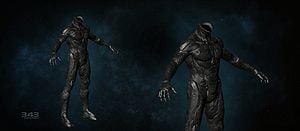
Sandwiched between the external armor and the internal padding is a thick black armored bodysuit. This suit has numerous functions, small but vital to the safety and survival of the wearer. The bodysuit is made of a titanium-based material, making it very strong and yet very flexible. It also serves as another layer of protection against ballistics attacks and is coated with a heat resistant material to disperse heat from plasma weapons.[41]
- Biofoam injectors:
Known to be present in the Mark V[42] and VI generations, biofoam injectors are an integral part of the systems ability to keep a Spartan-II functioning in battle. Biofoam is a medical gel that is used to fill and seal a wound automatically, it is also used to treat any infection that could occur as a result of the wound. The process of injecting, or applying the gel to a wound is extremely painful and is only a temporary solution; medical attention must be sought soon after to ensure survivability.
Reactive Circuits are systems installed directly linked to the Spartan neural interface. They amplify the wearer's reaction time by connecting directly to the thoughts of the wearer, making it much easier to control and allowing for the soldier to be both more efficient and have a higher survival rate in combat.
- Lockdown system:
The lockdown system protects muscles and joints from traumatic, high-impact injuries by seizing the suit into a rigid posture through modifying the density of the hydrostatic gel layer.[43][44][45]
Outer components[edit]
- Integrated communications helmet:
The Mjolnir helmet is one of the most vital aspects to the MJOLNIR armor system. It is made of titanium and features a heads-up display, that links to the brain and hands, and can identify equipment and display information about it when it is picked up by the wearer. An environmental control unit that includes filters to remove toxins from the atmosphere, and a rebreather to automatically supply oxygen to the wearer during EVA. In addition the helmet is packed with thermal and motion sensors, communications, solar-powered lighting, and imaging and video gear.
The most important feature though, is the direct neural interface system which connects to a Spartan's neural implants. Two core processor chips are implanted into the subjects skull in the rear of the head. This is essentially comparable to an on board computer using parts of the human brain for processing - when the connector at the rear of the subject's head and receptors in the brain link to the helmets on board sensors it creates the neural link needed to move the MJOLNIR suit.[5]
- Titanium alloy outer shell:
The outer shell of the Mjolnir armor is composed of a fairly thick titanium alloy. This plating covers the chest, arms, hip, legs, calves, feet and hands. This alloy is very resilient, can take significant punishment, and is nearly impervious to small arms fire. While enough shots from armor piercing rounds will breach the outer shell, the suit can take a few glancing blows from them without compromising the armor. The outer shell of all MJOLNIR suits is covered with a refractive coating to help disperse the heat experienced from Covenant energy weapons. However one or two direct hits from any plasma weapon will compromise the armor plating.[41]
- Memory processor superconductor layer:
Introduced with the Mark V, this layer allows a starship-grade AI to travel with a soldier into the field. The AI can then aid the soldier in software intrusion, hardware hacking, and espionage by listening to enemy chatter.[46]
- Magnetic weapon holder strips:
These strips are very small yet powerful magnets place on the legs, waist, and back of the suit and is used to hold any equipment with a magnetic property. The suit also contains an electromagnetic system on the boots of the MJOLNIR suit that allow its wearer to stay attached to a metal surface in zero G environments and can be toggled on or off by the wearer.
Unsuccessfully tested with the Mark IV,[47] properly introduced with the Mark V, and later refined with the Mark VI, the energy shield device is reversed engineered from Covenant technology. In 2532,[12] forty scientists and technicians would spend the next 20 years attempting to make some use of the technology. For decades the attempts at cracking their technology had met with failure after failure, some had given up and others in the scientific community believed the energy shield technology could never be cracked. However at some point in the late 2540s a breakthrough was made and for the first time the UNSC had successfully cracked and improved upon the technology.[48]
- Power plant:
Integrated into the final production model of the Mark IV in 2531, the microfusion cell is the most vital component to the Mjolnir system, as it provides power to all components of the armor. The reactor is built into the suit and allows for nearly unlimited power. The fusion reactor is half the size of a normal battery pack.[49] Pre-2531 versions of the armor use a nuclear fission reactor as a source of power. However, because of the delicacy and radioactive nature of the fission reactor its use was limited until it was replaced with a fusion plant in the final production model of the Mark IV.[20][50]
The power supply control unit controls the power supply of the armor.
This system functions as a self-destruct mechanism in order to prevent a dead Spartan's armor from being compromised by hostiles. It is activated by a series of digits that only the Spartans know. When engaged, it produces a reactor overload that burns everything within a ten-meter radius, then produces a large blast.[51]
Non-canon and dubious canon appearances[edit]

Silver Timeline[edit]
- Main article: Silver Timeline
MJOLNIR powered assault armor[52] was a suit of armor worn by SPARTAN-II soldiers. While several of the SPARTANs wear full Mark IV suits,[53] John-117 has access to a Mark VI helmet.[52]
Trivia[edit]
- Out-of-universe, MJOLNIR armor takes its name and designation scheme from Bungie's earlier Marathon series, in which the player character is a Mjolnir Mark IV "battleroid" cyborg.
- The Limited Edition of the Xbox 360 action RPG Fable II includes a set of MJOLNIR armor for the player's character to wear. It is called "Hal's Armor/Outfit". Additionally, the player can obtain a longsword with a crystal blade carved in the shape of the plasma envelope of the Energy Sword called "Hal's Sword". The name 'Hal' (obviously derived from 'Halo') is described in-game as the name the citizens of Albion gave to a mighty hero from another world. Also in the downloadable Knothole Island add-on, in the "Box of Secrets", the player can unlock 'a rare ranged weapon', "Hal's Rifle", which is an assault rifle.
Gallery[edit]
Shi Kai Wang's preliminary sketch of John-117 in what would become the Mjolnir Mark V for Halo: Combat Evolved.
Concept art of John-117 undergoing armor diagnostics for Halo 3.
A redux of the MJOLNIR Mark V for Halo 3.
Concept art of the Mjolnir Mark IV for Halo Wars
An early concept of a Mjolnir armor in Halo 4.
Mark V, Mark VI, and Keystone in Halo 4.
Mark V Delta, Mark V Alpha, Mark IV, and Mark VI in Halo 5: Guardians.
Concept for an up-armored Mjolnir suit for Halo Wars 2.
Concept art of a young John-117 in Mjolnir for Halo Infinite.
John-117 in an early version of his GEN3 Mjolnir Mark VI in the Halo Infinite announcement trailer.
List of appearances[edit]
Notes[edit]
- ^ a b The 2009 and 2011 editions of the Halo Encyclopedia claim that these manufactured suits were of the Mark I generation specifically, and that they were later "scrapped" - suggesting an intention to actually put them into service. However, the 2022 edition of the Encyclopedia revises this claim, stating that the "at least forty" manufactured suits were of the Mark I, II and III platforms overall (not Mark I specifically), and establishes that they were only ever testbeds for experimentation, never production-ready suits of armour. Due to the recency of the 2022 edition, and the frequent inaccuracies in the 2009 and 2011 encyclopaediae, this article favours the 2022 edition.
- ^ The 2009 and 2011 editions of the Halo Encyclopedia also claim that the Mark I allowed the user to lift up to two tons (4,000 pounds) and run at 32 km/h (19.88 mph) for extended periods of time. However, these statistics were ascribed to the unrelated Mark I prototype exoskeleton by Halo: The Fall of Reach, and misattributed to MJOLNIR Mark I by the Encyclopedia. Thus, they are not listed on this article.
- ^ The 2009 and 2011 editions of the Halo Encyclopedia state that it took a decade to develop the MJOLNIR Mark I. However, given that development of MJOLNIR only began in 2515, and that Mark IV was submitted to evaluation for mass production in February 2525, this would leave only 2 months for Mark II, III and IV to be produced. Given the implausibility of this, and the fact that the 2009 and 2011 Halo Encyclopediae are known to be frequently inaccurate, this article chooses to ignore this stated timeframe.
- ^ The image used to illustrate this information in the Encyclopedia is that of the Mark VI. Whether this layer was widely used across all versions of either generation is unknown as Master Chief thus far is the only known Spartan-AI instance.
Sources[edit]
- ^ Halo Waypoint -Halo 4 Armor
- ^ Halo 4: The Essential Visual Guide, page 229
- ^ a b Halo: Combat Evolved PC Strategy Guide, page 5
- ^ Halo 4, campaign level Reclaimer
- ^ a b c d e f g h i j k l m n Halo Encyclopedia (2009 edition), page 88
- ^ Halo: The Fall of Reach page 116 (2001 edition), page 133 (definitive edition) page 138 (2010 edition)
- ^ a b c d e f g h i j k Xbox.com: The Master Chief's Armor: An Overview (defunct, Archived)
- ^ a b Halo: The Fall of Reach, page 114-115 (2001 edition) page 131 (definitive edition) page 137 (2010 edition)
- ^ a b c d Dr. Halsey's personal journal September 1, 2525
- ^ a b c Halo: The Fall of Reach, page 115 (2001 edition) page 132 (definitive edition) page 137 (2010 edition)
- ^ a b c d e Dr. Halsey's personal journal June 30, 2525
- ^ a b c Halo Encyclopedia: The Definitive Guide to the Halo Universe, page 89
- ^ Halo: The Fall of Reach, page 118, (2001 edition) page 135, (definitive edition) page 140 (2010 edition)
- ^ a b c Dr. Halsey's personal journal July 30, 2511
- ^ Halo: The Fall of Reach, page 2, (2001 edition) page 3, (definitive edition) page 16 (2010 edition)
- ^ a b c Halo: The Fall of Reach, page 71, (2001 edition) page 81, (definitive edition) page 90 (2010 edition)
- ^ Halo: The Essential Visual Guide, page 44
- ^ Halo Waypoint, Canon Fodder - Anniversary Armory (Retrieved on Nov 3, 2021) [archive]
- ^ a b c d e f g h i j Halo Encyclopedia (2022 edition), page 77
- ^ a b Dr. Halsey's personal journal January 7, 2535
- ^ a b c Halo 4: ORDNANCE + ARMOR
- ^ a b c Halo 4 Official Site: GAMEPLAY
- ^ Halo Encyclopedia (2022 edition), page 78-79
- ^ Halo Encyclopedia (2022 edition), page 80
- ^ Bungie.net: Bungie Weekly Update: 01.29.10
- ^ Halo: Glasslands, page 291
- ^ a b c d Halo Waypoint: MJOLNIR
- ^ a b c Halo: Official Spartan Field Manual, pg. 178-179
- ^ Halo 4, Warrior armor description
- ^ Halo 4, Recruit armor description
- ^ a b Halo Encyclopedia (2022 edition), page 85
- ^ Discover Hope
- ^ Halo Waypoint, Canon Fodder - Despite Distance (Retrieved on Mar 30, 2023) [archive]
- ^ Halo: Shadows of Reach, Chapter 16
- ^ Halo Waypoint, Canon Fodder - Parallel Threads (Retrieved on Mar 30, 2023) [archive]
- ^ Halo: First Strike page 13 page 20 (2010 edition)
- ^ Halo: Ghosts of Onyx page 36
- ^ a b Halo Encyclopedia (2011 edition) - Project: MJOLNIR, page 91
- ^ Halo: First Strike, chapter 7
- ^ Halo: First Strike, page 19, page 31 (2010 edition)
- ^ a b Halo Encyclopedia: The Definitive Guide to the Halo Universe, page 90
- ^ Halo: First Strike, page 244 (2003)
- ^ Halo 3, level Arrival
- ^ Halo Encyclopedia: The Definitive Guide to the Halo Universe, page 91
- ^ Halo: Reach, level Tip of the Spear
- ^ Halo: The Fall of Reach, page 252, (2001 edition) page 292, (definitive edition) page 286 (2010 edition)
- ^ Halo: The Essential Visual Guide, page 119: "Energy shielding was a key feature of Mark V, although other Spartan squads had field-tested prototypes of this technology as early as 2531." The Grenadier variant, introduced four years later, also served as a test bed for energy shielding.
- ^ Halo: The Fall of Reach, page 249 (2001 edition) page 289, (definitive edition) page 283-284 (2010 edition)
- ^ Halo: The Fall of Reach, page 114, (2001 edition) page 131 (definitive edition) page 137 (2010 edition)
- ^ Halo: Ghosts of Onyx page 45
- ^ Halo: First Strike, page 315, page 377 (2010 edition)
- ^ a b Halo: The Television Series: London Premiere descriptions "Master Chief - Mark VI helmet: The Master Chief wears a prototype Mark VI helmet, with legacy MJOLNIR powered assault armor integration handled by custom firmware written by Dr. Halsey. The helmet extends and enhances the Chief's natural talent for coordination and situational awareness, helping him direct Silver Team to maximum effectiveness."
- ^ Halo: The Television Series: London Premiere descriptions "Kai-125 - Berta helmet: Kai's Mk. IV/B helmet was developed alongside a Spartan-specific variation of the HRUNTING/YGGDRASIL Mark I Armor Defense System. Kai has modified her suit with sniper targeting interlinks and "smart shot" interfaces suited for her long-range fighting style."
| ||||||||||||||||||||
| ||||||||||||||||||||||||||
